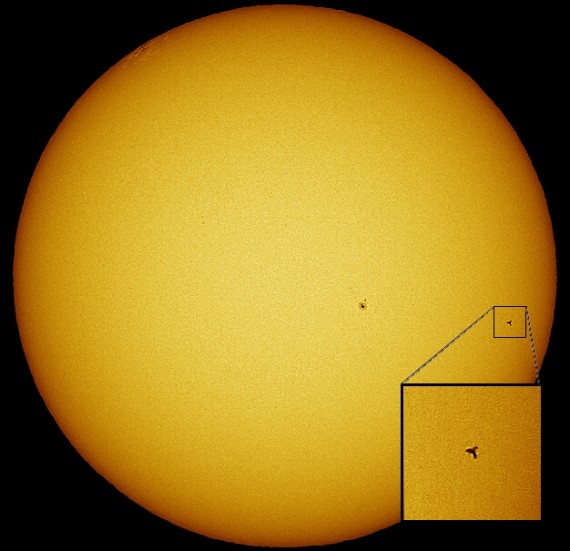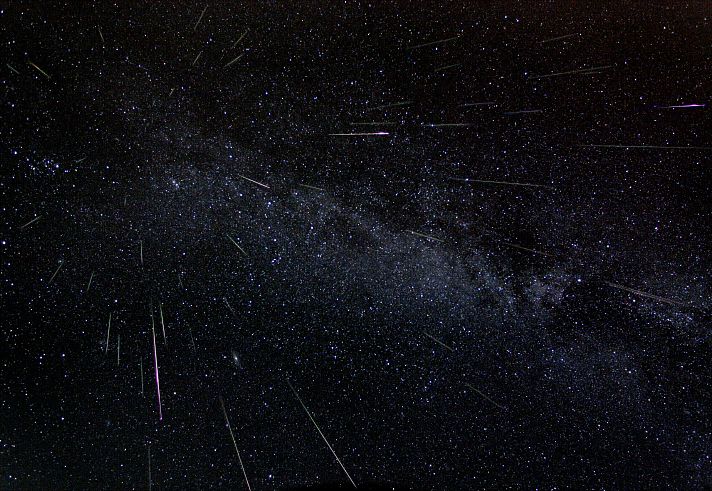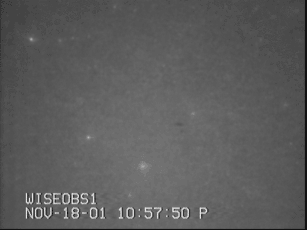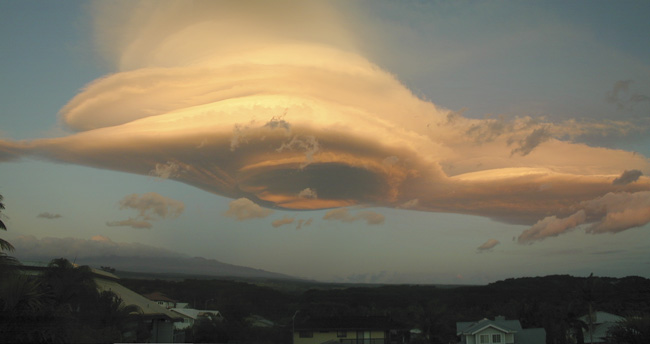Eine meiner Lieblingsseiten im Internet ist "Astronomy Picture of the Day". Ich habe vorhin wiedermal reingeschaut und dabei spektakuläre Bilder gefunden, die ich euch unbedingt mal zeigen möchte (wenn ihr sie nicht ohnehin schon gesehen habt  ). Schaut doch auch mal gelegentlich rein und postet eure Lieblingsbilder. Hier der Link.
). Schaut doch auch mal gelegentlich rein und postet eure Lieblingsbilder. Hier der Link.

2005 July 29 - ISS and Discovery Transit the Sun (larger image)
Image Credit & Copyright: Anthony Ayiomamitis
Explanation: That large sunspot near the right edge of the Sun is actually not a sunspot at all. It's the International Space Station (ISS) and the Space Shuttle Discovery on mission STS-114. In the past, many skygazers have spotted the space station and space shuttles as bright stars gliding through twilight skies, still glinting in the sunlight while orbiting 200 kilometers or so above the Earth's surface. But here, astronomer Anthony Ayiomamitis took advantage of a rarer opportunity to record the spacefaring combination moving quickly in silhouette across the solar disk. He snapped the picture on Thursday, July 28th from Athens, Greece. Launched on Tuesday, Discovery joined with the ISS Thursday, making the already large space station seem to loom even larger.

2005 August 6 - Raining Perseids (larger image)
Credit & Copyright: Fred Bruenjes
Explanation: Comet dust rained down on planet Earth last August, streaking through dark skies in the annual Perseid meteor shower. So, while enjoying the anticipated space weather, astronomer Fred Bruenjes recorded a series of many 30 second long exposures spanning about six hours on the night of August 11/12 using a wide angle lens. Combining those frames which captured meteor flashes, he produced this dramatic view of the Perseids of summer. Although the comet dust particles are traveling parallel to each other, the resulting shower meteors clearly seem to radiate from a single point on the sky in the eponymous constellation Perseus. The radiant effect is due to perspective, as the parallel tracks appear to converge at a distance. Bruenjes notes that there are 51 Perseid meteors in the composite image, including one seen nearly head-on. This year, the Perseids Meteor Shower will peak in the early morning hours on Friday, August 12.

2005 August 12 - A Meteor Shower Fireball Movie
Credit & Copyright: D. Polishook, N. Brosch, & I. Manulis (Tel-Aviv U., Wise Obs.), and Spacegaurd Israel
Explanation: Go outside tonight and see a celestial light show -- the later the better. Tonight is the peak of the month-long Perseid Meteor Shower. Although visible every year at this time, the Perseids are expected to appear particularly active this year due to the relative absence of glare from the Moon during the peak. Tonight, a thin moon will set a few hours after the Sun, leaving a moonless and dark sky. All through the night, all over the sky, meteors will appear to shoot out the constellation Perseus and across the sky. The rate of meteors and fireballs is not known for sure, but expected by some to be as high as one meteor flash every minute. Lucky sky gazers might be treated to a bright fireball like the one pictured above. That fireball was captured by a digital recorded over Wise Observatory during the 2001 Leonid Meteor Shower. The meteor shower poses no danger as few, if any, of the sand-sized flaring bits are expected to reach the ground.

2005 August 21 - A Lenticular Cloud Over Hawaii (larger image)
Credit & Copyright: Peter Michaud (Gemini Obs.)
Explanation: Can a cloud do that? Actually, pictured above are several clouds all stacked up into one striking lenticular cloud. Normally, air moves much more horizontally than it does vertically. Sometimes, however, such as when wind comes off of a mountain or a hill, relatively strong vertical oscillations take place as the air stabilizes. The dry air at the top of an oscillation may be quite stratified in moisture content, and hence forms clouds at each layer where the air saturates with moisture. The result can be a lenticular cloud with a strongly layered appearance. The above picture was taken near Mauna Kea, Hawaii, USA.
 ). Schaut doch auch mal gelegentlich rein und postet eure Lieblingsbilder. Hier der Link.
). Schaut doch auch mal gelegentlich rein und postet eure Lieblingsbilder. Hier der Link.
2005 July 29 - ISS and Discovery Transit the Sun (larger image)
Image Credit & Copyright: Anthony Ayiomamitis
Explanation: That large sunspot near the right edge of the Sun is actually not a sunspot at all. It's the International Space Station (ISS) and the Space Shuttle Discovery on mission STS-114. In the past, many skygazers have spotted the space station and space shuttles as bright stars gliding through twilight skies, still glinting in the sunlight while orbiting 200 kilometers or so above the Earth's surface. But here, astronomer Anthony Ayiomamitis took advantage of a rarer opportunity to record the spacefaring combination moving quickly in silhouette across the solar disk. He snapped the picture on Thursday, July 28th from Athens, Greece. Launched on Tuesday, Discovery joined with the ISS Thursday, making the already large space station seem to loom even larger.

2005 August 6 - Raining Perseids (larger image)
Credit & Copyright: Fred Bruenjes
Explanation: Comet dust rained down on planet Earth last August, streaking through dark skies in the annual Perseid meteor shower. So, while enjoying the anticipated space weather, astronomer Fred Bruenjes recorded a series of many 30 second long exposures spanning about six hours on the night of August 11/12 using a wide angle lens. Combining those frames which captured meteor flashes, he produced this dramatic view of the Perseids of summer. Although the comet dust particles are traveling parallel to each other, the resulting shower meteors clearly seem to radiate from a single point on the sky in the eponymous constellation Perseus. The radiant effect is due to perspective, as the parallel tracks appear to converge at a distance. Bruenjes notes that there are 51 Perseid meteors in the composite image, including one seen nearly head-on. This year, the Perseids Meteor Shower will peak in the early morning hours on Friday, August 12.

2005 August 12 - A Meteor Shower Fireball Movie
Credit & Copyright: D. Polishook, N. Brosch, & I. Manulis (Tel-Aviv U., Wise Obs.), and Spacegaurd Israel
Explanation: Go outside tonight and see a celestial light show -- the later the better. Tonight is the peak of the month-long Perseid Meteor Shower. Although visible every year at this time, the Perseids are expected to appear particularly active this year due to the relative absence of glare from the Moon during the peak. Tonight, a thin moon will set a few hours after the Sun, leaving a moonless and dark sky. All through the night, all over the sky, meteors will appear to shoot out the constellation Perseus and across the sky. The rate of meteors and fireballs is not known for sure, but expected by some to be as high as one meteor flash every minute. Lucky sky gazers might be treated to a bright fireball like the one pictured above. That fireball was captured by a digital recorded over Wise Observatory during the 2001 Leonid Meteor Shower. The meteor shower poses no danger as few, if any, of the sand-sized flaring bits are expected to reach the ground.

2005 August 21 - A Lenticular Cloud Over Hawaii (larger image)
Credit & Copyright: Peter Michaud (Gemini Obs.)
Explanation: Can a cloud do that? Actually, pictured above are several clouds all stacked up into one striking lenticular cloud. Normally, air moves much more horizontally than it does vertically. Sometimes, however, such as when wind comes off of a mountain or a hill, relatively strong vertical oscillations take place as the air stabilizes. The dry air at the top of an oscillation may be quite stratified in moisture content, and hence forms clouds at each layer where the air saturates with moisture. The result can be a lenticular cloud with a strongly layered appearance. The above picture was taken near Mauna Kea, Hawaii, USA.










Kommentar